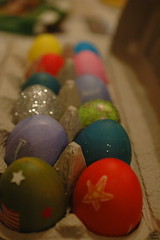This morning, I took a quiz How Much Do You Know About Passover Foods? at Serious Eats. I thought I'd score miserably, considering my experience with Passover foods is limited to drinking from specially marked bottles of Coca Cola and celebrating Seder meals with my friend Jeremy's family when I was in high school. (In fact, I learned almost everything I know about Jewish customs and practices, especially those surrounding food, by eating over at Jeremy's house.)
I got 50% correct, a score that would have sent me in to tears at 16 if it had been on a grammar test. But, considering it's been more than 10 years since I shared in a Jewish Seder, I think I did OK.
It got me thinking about Easter food customs. Pre-cooked hams and butter lambs adorn grocery store endcaps and sale flyers. Children's easter baskets brim with Cadbury eggs, robins' eggs, and pastel shaded M&Ms. And of course, there are Peeps, those strangely colored confections that I think should be made into sweetly colored Easter decorations rather than be consumed as food. And I remember vividly, if not fondly, taking egg salad sandwiches for lunch the week after Easter tinted with blue and green thanks to some dye that had somehow seeped through the eggshells and onto the hardboiled eggs.
What disappoints me about American Easter food is how 1950s pre-fab it all seems (or, at least what I imagine 1950s pre-fab to be). In one day, we go from eating simple soup and bread suppers and fasting from meat, candy, or whatever other vices we've decided to omit from our diets for 7 weeks to gorging ourselves on highly-processed, chemical-laden, mass-produced junk. It hardly sounds like a meaningful celebration of the Resurrection to me.
Forgive me if I sound like I'm down on Easter traditions. The thing is, I very much value tradition and absolutely appreciate that brightly colored jelly beans from the candy aisle are meaningful to a lot of people. I always preferred the jelly beans inside plastic easter eggs to the foil-wrapped chocolate eggs that my mother would hide around the house for my sister and me to find (sometimes months later).
My concern is that we ought not undermine all the work we do during Lent. As we prepare for our joyful feasts this weekend, perhaps we should pause for prayer and reflection before hitting the supermarket sales. Those of us who've chosen to stick to a vegetarian diet for the past 40 days might consider what goes into the raising of a pig who ends up a pre-cooked and cured ham piled high in a refrigerated bin at the grocery store. If you've given up chocolate, why not pass on buying several bags of cheaply-priced chocolate eggs and pay what you would have spent for a bar or two of chocolate you know has been fairly-traded . You'll end up with less candy, for sure, but it will be something to be savored and enjoyed rather than mindlessly consumed in mass quantities. And for eggs, consider something local or free-range for your celebration.
Frankly, I can't think of a better way to celebrate the Resurrection, the promise of eternal life, than by purchasing and consuming that which is sustainable and life-giving to farmers, to the earth, to the animals, and to us.









